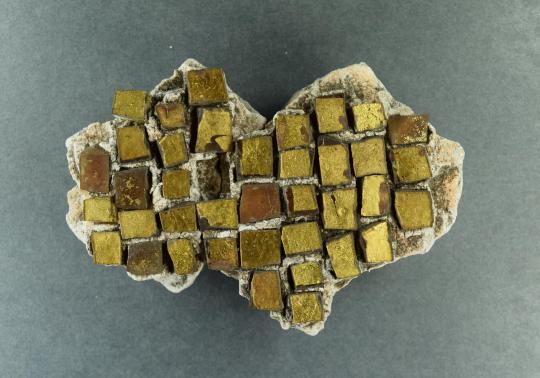#A Byzantine Mosaic Fragment
Photo
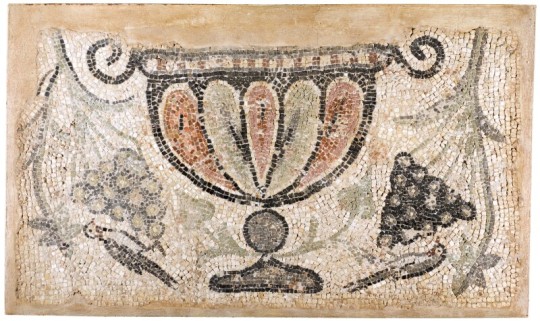
A Byzantine Mosaic Fragment
Circa 5th/6th Century A.D.
Depicting in multi-coloured tesserae a gadrooned vase with voluted handles flanked by hanging vines and two birds each pecking at a cluster of grapes.
78 by 130 cm.
#A Byzantine Mosaic Fragment#Circa 5th/6th Century A.D.#archeology#archeolgst#mosaic#ancient artifacts#ancient art#art#artist#art work#art news#history#history news#ancient history#ancient culture#ancient civilizations
196 notes
·
View notes
Text
"I think this is my favourite way to touch you" she said lovingly, while gently tracing circle after circle with her nails along my bare back.
"What?"
"Scratching your back, I think it's one of my favourite ways to touch you. That, or playing with your hair."
I post a lot about how stone4stone love has been healing for me in a way that is so profound and almost spiritual, but finally having it in person has only taken that to a whole other level. My darling femme saying this caused my entire world to slow down as I processed what, up until that point, I thought impossible. A fantasy that would never fully be spoken.
For context, my top three favourite ways to be given physical intimacy/love are the following:
Having my hair played with over long periods of time
Scratching my back and scalp
Massage, especially when chronic pain flare ups are bad
I react so intensely that it excites people a lot of the time. You'd think I was having sex if you were simply listening to the sounds from the other room (which is ironic given I actively hate receiving during, joys of being stone). For my entire life, for my nearly 15 years of dating, every single person before my femme has followed the same pattern.
They'll discover how positively I react to scratches/hairplay, and they actively engage in it regularly due to the advent of your new partner enjoying something that much. Inevitably they get bored but will continue because it makes me happy. Eventually though, the novelty fully wears off and the only true way I can get that level of attention is when I explicitly ask for it. I've often gotten sighs followed by "oh alright" as if it's some chore, or worse yet, half sarcastic "if only you made sounds like this during sex". Every single time I'd inevitably start feeling guilty, anxious, and simply stop asking.
The sheer number of times I'd ask myself "if I said I never wanted to receive during sex again, if I wanted intimacy in only this way, would so-n-so be upset" and the answer was always yes. Always. I'd begun to internalize that my way of receiving was a chore. That how I wanted to be loved was a reward to be earned.
Then comes this absolute darling of a femme, unprompted during our quiet night of non-sexual intimacy after a long day, casually dropping that her favourite way to show me physical intimacy is tied between scratching my back and playing with my hair. By accident in a single half-entraced phrase she took my perceptions of love, what I deserve from love, and what I could expect to receive, shattered them into a thousand fragments, and then stitched them back together into a mosaic that would make the Byzantines weep.
There is something to be said for your partner loving you in a specific way because it is how you like to be showed love, even though it's not their preferred method of showing it. It is a league-of-its-own different feeling to find someone who shows you love the way you want to be shown love because it's how they prefer to show love. She has taught me that and I am never settling for less again.
I've said it before, and I'll say it again.
Stone4Stone is Holy.
#this femme y'all#i love her so much#finally writing about the trip#oh vampling... 💕#stone4stone is holy#bite me#stone4stone#butch#lesbian#wlw#nblw#sapphic#stone lesbian#stone butch#stone top#butch/femme#butch/femme culture
164 notes
·
View notes
Text
For #WorldCamelDay:

Mosaic Fragment with Grazing Camel
Byzantine; Eastern Mediterranean, probably Syria, 5th century
Stone in mortar, 143 × 166.5 × 6.5 cm (56 1/4 × 61 1/2 × 2 1/2 in.)
On display at Art Institute of Chicago
“This image of a grazing camel probably came from a larger composition with other animals that decorated the floor of a semipublic space within a private home, such as a reception or dining room. This animal is represented against a white ground decorated with florets. A bell hangs from the camel’s neck as it reaches toward an object, perhaps a vessel filled with water, at the lower right. The knobby contours of the camel’s body are accentuated by areas of shading in subtly modulated colors, including black, brown, brick red, and olive green.”
info via https://www.artic.edu/artworks/35355/mosaic-fragment-with-grazing-camel
#camel#ancient art#Byzantine art#5th century art#Art Institute of Chicago#museum visit#mosaic#World Camel Day#animal holiday#animals in art#Near Eastern art
61 notes
·
View notes
Photo


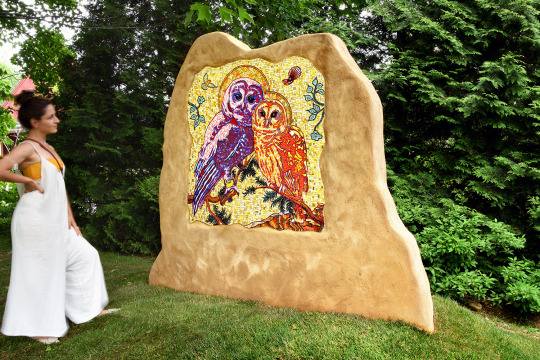

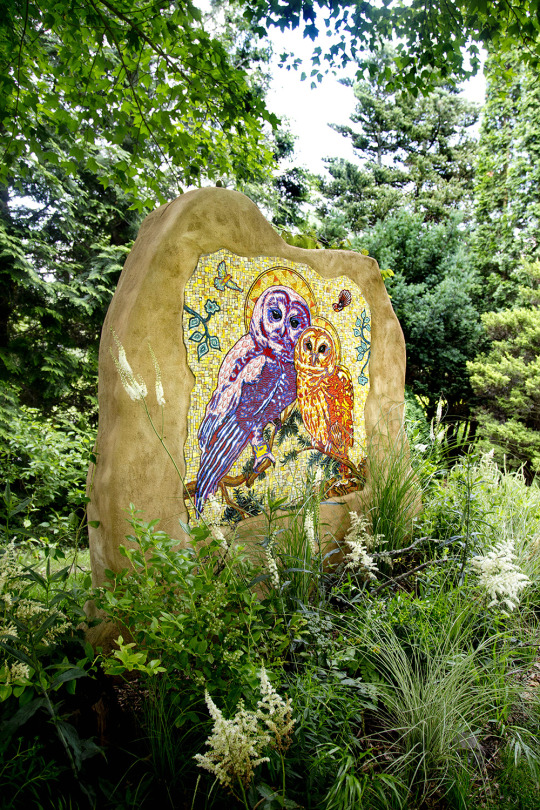

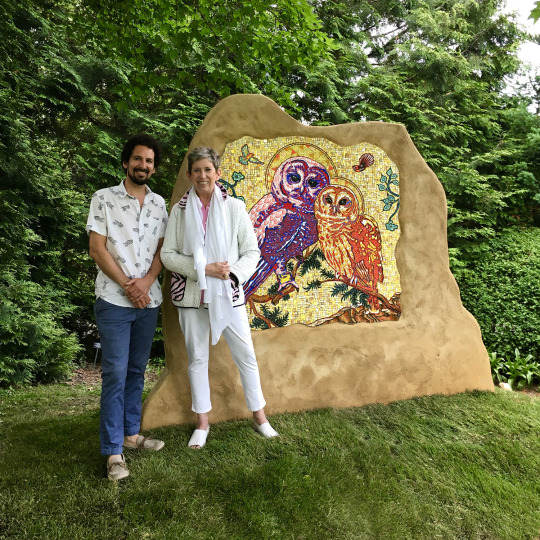


Spotted Owl Mosaic — A Site-Specific Installation by Peter D. Gerakaris for the Berkshire Botanical Garden, translated into mosaic by Miotto Mosaic Art Studios. Curated by Beth Rudin DeWoody. 81 in. x 92 in. x 12 in, Glass Mosaic on stucco wall w/ live plants. 2021. Permanent Collection of the Berkshire Botanical Garden (BBG). Photos Courtesy: BBG, the Artist, & Mary Gerakaris
Spotted Owl Mosaic translates Peter D. Gerakaris’ vibrant original painting into a site-specific garden mosaic installation, presenting these endangered owls as Neo-Byzantine icons of our contemporary environment.
Enveloped by plants, the architectural garden folly welcomes the public through a nostalgic sense of place — like a fragment of civilization reclaimed by nature. The mosaic process itself — which literally creates new imagery from broken fragments — underscores notions of rebirth and the mending of society’s fractured relationship with the environment.
More about this public artwork:
Project portfolio: https://www.petergerakaris.com/spotted-owl-mosaic-berkshire-botanical-garden
Short video doc: https://youtu.be/dL_jhKzl68Y
Article: https://www.berkshireeagle.com/news/southern_berkshires/berkshire-botanical-garden-art-first-grade-teacher-reaction/article_8cd3e084-2847-11ec-8e41-436efd31b5d4.html
#botanical garden#berkshire botanical garden#berkshires#mosaic#mosaic art#byzantine art#icon#gold#garden#public art#owl#owls#nature#beth rudin dewoody#stephen miotto#miotto mosaics#peter gerakaris#gerakaris#Peter D Gerakaris#new england#artist
109 notes
·
View notes
Text





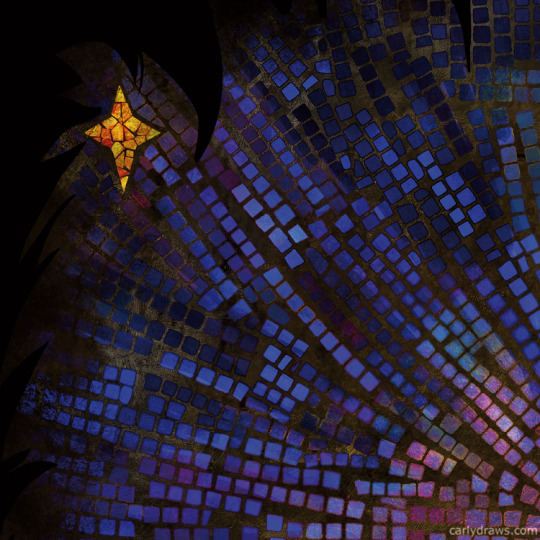

Here is the time i did a byzantine mosaic style front cover piece for Fusion Fragment, telling the story of a mythic bird flight through space.
Wanted the piece to look like an ancient mosaic on Earth, surrounded by nature and left in peace.
Check out the story for free on their site :-)
9 notes
·
View notes
Text

Ibex near a Tree
Fragment of a Floor Mosaic: Ibex near a Tree, 400s. Byzantium, Northern Syria, Byzantine period, 5th century.
source
2 notes
·
View notes
Text

A Stroke of Luck: A rare 2,500-year-old marble disc, designed to protect ancient ships and ward off the evil eye, was discovered by a lifeguard diving at sea and handed over to the Israel Antiquities Authority. >> 🧿
A marble disc, dating to the 5th–4th centuries BCE, was found during a dive by lifeguard David Shalom at the Yavne-Yam archaeological site near Palmachim Beach. Yaakov Sharvit, Director of the Marine Archaeology Unit at the Israel Antiquities Authority, explains: “From drawings on pottery, mosaics, and ancient coins, as well as from historical sources from the 5th century BCE, we learn that this design was common on ships’ bows and served to protect against the evil eye and envy, aided navigation, and acted as a pair of eyes looking ahead and warning of danger. This decoration is still common today on modern ships in Portugal, Malta, Greece, and the far east.”
The large white marble disc, 20 cm diameter, is flat on one side and curved on the other, and it has a central cavity with traces of paint appearing as two circles around the center. It is identified as an eye motif, in Greek “ophtalmoi,” and such discs adorned the bows of ancient warships and merchant vessels. Lead or bronze nails attached the center of the disc to the ship’s hull.
Although this artifact was once common and one would expect to find many similar artifacts, it is, in fact, rare. So far, only four similar ancient items have been discovered in the Mediterranean: two from the wreck of an ancient merchant ship found at the Tektaş Burnu site off the western coast of Turkey, between the islands of Samos and Kios, dating to 440–425 BCE, and two on the Mediterranean coast of Israel—one from the Carmel Beach and the other, just discovered, on the Yavneh-Yam coast.
“Yavne-Yam was settled for the first time in the Middle Bronze Age,” Sharvit says, “and was settled down to the Middle Ages. Near the ancient mound, there is a natural sheltered anchorage protected by a rock promontory.”
In water surveys conducted by the Marine Archaeology Unit of the Israel Antiquities Authority since the 1980s, finds from shipwrecked ships testifying to extensive commercial activity at the site were discovered. These include anchors of various sizes and weights with one to three holes, fishing equipment, lead weights, and stone anchors. Items used on ships were also found, including a lead cooking oven, grinding stones, stone bowls, fishing tools (bronze fishhooks, lead fishing nets, and lead depth measurement weights), as well as storage jars, amphorae, bowls, and cooking pots dating back to the Late Bronze Age, Persian, Hellenistic, Roman, and Byzantine periods!
Sharvit explains: “Many of the pottery vessels were manufactured in the Levant or the eastern Mediterranean, but some were imported from distant Mediterranean countries.” The site revealed many Bronze Age finds, including dozens of gold items (earrings, beads, jewelry fragments, ingots, and jewelry industry waste), as well as a Syrian hematite seal. The finds were scattered in the area where 20 stone anchors, bronze arrowheads, tridents, and two figurines of the god Baal were discovered in the past. The archaeological finds indicate that the anchorage was in continuous use from the Late Bronze Age down to the medieval period.
Do you know what other talismans were used to ward off the evil eye? Share them with us!
Photography: Israel Antiquities Authority
Source: Facebook
2 notes
·
View notes
Photo

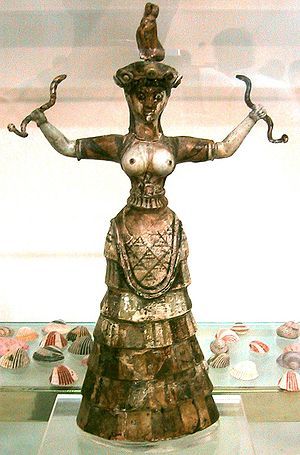
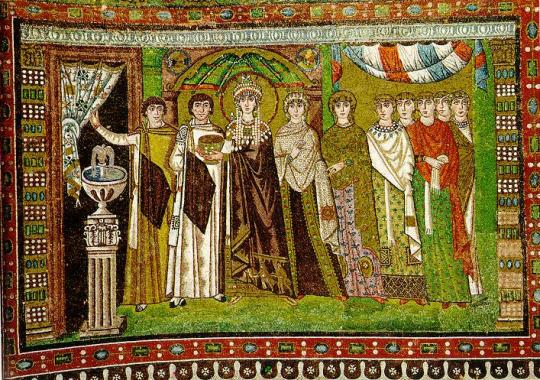






mother
1 'artist' unknown Venus of Willendorf (c28000-25000BCE) limestone http://smarthistory.khanacademy.org/nude-woman-venus-of-willendorf.html
2 artist unknown snake goddess, Minoan Civilization, Crete (c1600 BCE)
3 artists unknown Empress Theodora, mosaic in church of San Vitale, Ravenna, Italy (6th Century) http://smarthistory.khanacademy.org/byzantine-justinian.html
4 Ana Mendieta (1948-85) Cuba/ USA Silueta search at http://www.moca.org
5 Piero della Francesca (1415-92) Madonna of Mercy, detail (c1460) oil and tempera on panel
6 poster from Mehboob Khan's 1957 film Mother India http://www.youtube.com/watch?v=yNFPjvT5PJM http://www.youtube.com/watch?v=JzJHnADcpa8
7 Cindy Sherman Untitled (1989)
8 Maïmouna Patrizia Guerresi () As a photographer, sculptor, and installation artist, ‘Maïmouna’ Patrizia Guerresi reveals unique and authentic sensibilities in her narration of the beauty and subtleties of racial diversity and multiculturalism. Over an established career, she has developed her own symbolism, which combines cosmological and ancestral traditions belonging to various European, African, and Asian cultures. Her personal commitment to Baifall Sufism has led her to produce an aesthetic that is able to bridge time, space and civilisations, as well as figuration and abstraction.
The human body is seen as the nucleus and temple of the soul, a place that houses a delicate, higher awareness; the very conduit for encompassing natural and cosmic forces. More about mysticism than any singular religion, her work is visionary in that it restores those elusive qualities of sacredness and unity in our frequently dehumanising and fragmented contemporary visual world. Her classic iconographic style explores the universality of human experience and reclaims the often hidden nurturing powers of feminine energy. Presented as a kind of free flowing epic, the viewer is left to read the significance of her imagery and quietly meditate on its potential to personally engage with its audience. As if her figures were speaking directly to each one of us.
From her earliest experiments with the physicality and archetypal imprinting of the psyche, through to her latest, evermore metaphoric ‘inner constellations’, Maïmouna insists on a cross-cultural discourse and an expansion of the boundaries that normally dictate our individual attitudes. She invites us to see further and to look deeper – past skin colour, preconceptions, and ethnic landscapes – into the wider paradigm of inclusion. She leads us through apparently simple notions of dimensionality into the exquisite, mystical and fragile complexities of life from within. Rosa Maria Falvo,writer and curator, www.chobimela.org
Perspective on the relationship between women and society, with particular reference to those countries in which the role of women is most marginalized. For over twenty years Guerresi’s work has been about empowering women and bringing together individuals and cultures in an appreciation for a context of shared humanity, beyond borders – psychological, cultural, and political. She uses recurrent metaphors such as milk, light, the hijab, trees, and contrasting white on black to create awareness of the vital unifying qualities of the feminine archetype and its special healing potential. Guerresi’s art is uniquely authentic. Her work is inspired by personal experience and cultural contexts that reference universal myths, the sacred realm, and the female condition, all of which are seen as vital expressions of the human form: an essentially spiritual and mystic body. Through photographs and videos of silent, austere, veiled women in domestic scenes and individual poses, her work functions as both metaphor and provocation. Guerresi’s images are delicate narratives with fluid sequencing, as well as rational analyses: women dressed in white, enveloped in chadors, fixed within their own tradition and isolated from and by it in the contemporary world. Her Fatimah image suggests the woman as Mother- Earth supporting us in the original energy cycle of Space-Universe-Infinity. www.maimounaguerresi.com
9 The Cholmondeley Ladies (c1600-10) oil paint on wood 886 x 1723 mm British School 17th century (1600‑1699)
search @ www.tate.org.uk
#mother#earth#venus#figure#figurative#symbolism#representation#mendieta#minoan#mary#della francesca#willendorf#sherman#Guerresi#spiritual#mother india#cholmondeley#snake goddess
6 notes
·
View notes
Photo

MWW Artwork of the Day (9/28/22)
Byzantium (c. 350-1453 CE)
The Personification of Ktisis (c. 500–550 CE)
Marble & glass fragment of floor mosaic, 151.1 x 199.7 x 2.5 cm.
The Metropolitan Museum of Art, New York
This monumental bust of a richly bejeweled lady who wears large pearls in her ears, a necklace of delicate stones about her throat, and two brooches—one clasping her yellow mantle and another at the tie of her dress—is an example of the exceptional mosaics created throughout the Early Byzantine world in the first half of the sixth century. Both her elaborate diadem and the neckline of her dress are bordered with alternating black and white tesserae meant to suggest pearls. The addition of blue glass to represent sapphires, or "hyacinths," among the red and green glass gemstones on the mosaic is characteristic of sixth-century Byzantine taste. The rod that she holds, the measuring tool for the Roman foot, identifies her as a personification of the abstract concept of "Ktisis," or Foundation, and symbolizes the donation, or foundation, of a building.
For more Byzantine art, visit this MWW Special Collection:
https://www.facebook.com/media/set/?vanity=TheMuseumWithoutWalls&set=a.419770264795015
8 notes
·
View notes
Text
Dream Eater - Chapter 9 - Part 1

*Warning Adult Content*
"You fucking asshole," I scream, throwing a pillow in the general direction of Damien's voice. "Next time you kidnap me across dimensions, fucking tell me to close my 'God-damn fucking eyes'."
It's Day Three since I woke up blind and my vision is only marginally improved.
Allannan seems encouraged that it's improved at all but I feel close to despair at this point.
Damien has remained at my side with a constancy that would be sweet if it wasn't so annoying.
And if he hadn't made it so abundantly clear he's only interested in the fragment of Heavenly Key I carry in my fucked-up soul.
"Alex, please. I'm sure your vision will return in full soon. In the meantime, I'll do whatever you need. You just have to be patient."
"Fuck patient," I know I'm being whiney and obnoxious at this point but honestly, I'm bored and this is more entertaining than sitting in the courtyard and listening to the water fountains for hours.
Which is about all I've been doing for the past three days.
I had plenty of time to review my life choices and come to the conclusion that they all sucked ass.
'Especially' the choice to answer a job alert from one Damien Knight.
Like an idiot who continues to hold a hissing cat, Damien comes and sits next to me on the bed.
"Alex, I'm really sorry. I know you're scared and frustrated and angry. I just need you to hang in there a little longer. I promise your sight will return."
He brushes his hand over my hair and I jerk away.
Then, abruptly, my energy is gone and I don't feel like fighting anymore.
I sigh and submit as he runs a comb through my tangled curls.
He's assured me more times than I can count that we're safe here but for some reason, I can't quite relax enough to believe it.
Allannan and Deberon seem nice enough and from Damien's descriptions, Carnâk seems like a great place.
Apparently, it's like a state within a wider region.
The architecture sounds similar to the Byzantine style on Earth... lots of colorful mosaics, pillars, arches, domed roofs and towering spires.
The city we're in is called Ereb and Damien tells me it's a mishmash of Venice, Istanbul and Babylon, with lots of watery thoroughfares, vertical gardens and stunning architecture.
He tells me it's very beautiful and if I could see it, I'm sure I'd agree.
"We've been invited to a special session of the Council today," Damien tells me now. "Allannan holds a seat in the lower chamber, and she's going to propose a movement to extend asylum to us. If it passes, we'll be able to stay here as long as we like under the protection of Carnâk and it's people."
"I don't know what that means," I respond, going for reasonable but coming off sulky and miserable.
Which is how I feel.
Damien doesn't say anything for a minute.
"This Realm is kind of like... Switzerland," he said. "It stayed neutral during the rebellion, although many... especially here in Carnâk... sympathized with Sakariel and his cause. If we're given asylum, we'll be safer here than just about anywhere else in the Multiverse."
I sigh resignedly.
"Again... no idea what that means."
He huffs out a laugh.
"Sakariel was never this difficult," he says. "Or this..." whatever he was going to say gets cut off when someone knocks on the door.
Which is fortunate for him because his words have stirred the ashes of my fury... impotent though it may be.
Deberon's voice greets us.
"Damien, Alex... Blessings of Eos upon you. Are you ready to attend the Council?"
"A few moments, Deberon," Damien replies.
"Very good. I'll wait outside."
The door closes again but Damien remains silent and still.
After a long pause, he says...
"Alex, whatever happens today, please know that I am on your side. I am sworn to protect the Key but that doesn't mean I'm insensate to your feelings. I know you want to go home and that you'd rather be anywhere but here with me but... I'm glad it's you. I'm glad that whatever piece of Sakariel survived, it found a new life in someone so... luminous."
Once more, no idea what he means but it seems stupid to say so.
Instead, I shrug.
"Hey, it could be worse. I could be dead or still with my ex-boyfriend."
He chuckles and helps me into a set of fresh clothes.
They seem almost normal... loose, low-waisted trousers and a long tunic-like shirt.
The neckline is a little low but the temperature always hovers just around perfect here, so it doesn't bother me.
We join Deberon in the hallway outside and he leads the way down the long corridor and then outside.
Damien guides me down long, winding pathways and endless flights of stairs until I hear the soft gurgle and rush of water.
We reach the bank of a river and board a wide, flat barge that carries us swiftly downstream.
When we disembark, we walk along what feels like miles of gently sloping stone streets, until we arrive at the Council Courtyard, which Damien tells me looks a bit like the Colosseum in Rome.
Inside, I hear the murmur and clamor of many voices, which fall silent as we take our seats.
At first, I try to pay attention but I've never had much interest in politics and it seems like the issue of our asylum is a minor note that won't be addressed for quite some time.
Before I know it, I'm nodding off in my seat, lulled into a sort of half-sleep by the monotonous drone of self-important voices.
Eventually, Damien nudges me awake.
"It passed," he says, sounding ecstatic. "We're safe."
I try to feel happy about this and fail.
"That's great," I say. "What now?"
"Well, now that we're officially under the protection of the state, we'll be welcomed as honored guests. Allannan will hold a banquet in our honor in a few days. She'll also spread the word among the Faithful that the Key has been found. I think that more than a few of our old allies will be delighted to meet you, Alex."
I wish I felt the same.
"Great." I try to smile. "I love parties."
1 note
·
View note
Text
Discover the Splendor of Mosaic Candle Holders
New Post has been published on https://votivecandleholder.com/candle-decoration/discover-the-splendor-of-mosaic-candle-holders
Discover the Splendor of Mosaic Candle Holders
Prepare to be awestruck by the breathtaking magnificence of mosaic candle holders! These exquisite art pieces combine craftsmanship and creativity to bring forth a kaleidoscope of beauty and light. Here, we will discuss recognizing the meticulous skill behind mosaic candle holders, marvel at the vibrant colors that breathe life into these holders, and discover the versatility they bring to any space.
From their intricate patterns to their ability to enhance the ambiance, these decorative mosaic candleholders are a true testament to the creative thinking that goes into their production. Let’s commence on a journey where we can appreciate and celebrate the exceptional splendor of mosaic candle holders together!
Table of Contents
1 Unveiling the Artistic Craftsmanship
1.1 Blue mosaic candle holders
2 The Magic of Colors and Patterns
2.1 Glass mosaic candle holders
3 Illuminating Spaces with Warmth and Elegance
4 Enhancing Décor and Style
4.1 Turkish mosaic candle holders
5 The Versatility of Mosaic Candle Holders
5.1 Tall mosaic candle holders
6 Appreciating the Timeless Beauty
7 DIY mosaic candle holders
Unveiling the Artistic Craftsmanship
Discover the mesmerizing artistry of mosaic candle holders, where skill, passion, and attention to detail intertwine. Artisans thoroughly select and patiently arrange glass or ceramic fragments to create stunning designs. From classic Byzantine mosaics to contemporary abstract styles, the potential for creativity knows no bounds. With precision, they form these holders using various techniques.
Blue mosaic candle holders
Imagine delicate floral motifs and shimmering geometric designs on mosaic candle holders, showcasing the artisans’ dedication. With careful tile placement and color choices, they craft astonishing masterpieces. Balancing hues, shapes, and textures, they weave a harmonious tapestry of grace. Learn about the secrets and techniques behind mosaic candle holders, where dedication and devotion produce extraordinary radiance.
The Magic of Colors and Patterns
Experience the enchanting magic of colors and patterns in mosaic candle holders. The wide array of hues breathes life and vibrancy into their designs. Each choice evokes emotions and sets the tone, influencing the overall aesthetics. Dynamic hues generate visual impact, while cohesive combinations offer tranquility.
Elaborate patterns, from geometric shapes to delicate florals, captivate with their expressiveness. Carefully crafted with balance and contrast of colors, these holders exude depth and dimension. Colors hold immense significance, creating an ambiance that delights the senses.
Glass mosaic candle holders
Witness the captivating dance of light as mosaic candle holders cast figures and envelop their surroundings in a hypnotic glow. Be prepared to be absorbed by the gripping power of art, and indulge in an entrancing visual symphony.
Illuminating Spaces with Warmth and Elegance
Enjoy the irresistible impact of mosaic candle holders as they illuminate spaces with warmth and elegance. As candlelight gently dances, it enhances refined patterns and vibrant hues and transforms living rooms and gardens into elegant sanctuaries, hypnotizing guests with their presence.
From cozy nooks to romantic dinners, these mosaic candleholders infuse every occasion with marvel. Adorn your home, garden, or office with their radiant charm, establishing a haven of sophistication.
Enhancing Décor and Style
Let the compelling presence of mosaic tea light candle holders bring a touch of enchantment to every corner of your home. Choose from a variety of styles and themes to suit your taste, whether vintage, modern, or eclectic. These versatile holders seamlessly blend with your existing décor, complementing furnishings, colors, and textures for a cohesive and artistic atmosphere.
Turkish mosaic candle holders
Embrace the grace and flexibility of mosaic candle holders as delightful accents, with their complex designs, striking hues, and warm candlelight forming a magnetic spectacle. Place them on coffee tables or mantels, or use them as centerpieces to instill your surroundings with brilliance and reflect your distinctive style.
The Versatility of Mosaic Candle Holders
Delight in the versatility of mosaic candle holders, producing magical moments in any setting. Their elaborate designs steal the spotlight as centerpieces, transforming spaces into masterpieces. Explore unique placements in living rooms, bedrooms, outdoors, and bathrooms.
Tall mosaic candle holders
Looking for the perfect gift? Mosaic candleholders embody thoughtfulness, radiating affection, and glamour. Permeate outdoor patios with starlit wonder or bring serenity to bathroom counters. Let dining tables shine with comfort and romance. Ignite your imagination and clasp the boundless potential of mosaic candle holders.
Appreciating the Timeless Beauty
Indulge in the timeless appeal of mosaic candle holders that capture the essence of bygone eras while remaining captivating today. Their details and enduring proficiency are a testament to their artistry. Holding a mosaic candle holder is a reminder of the methodical work that transcends time. Welcome the nostalgia as you gaze upon the patterns and colors, transporting you to revered times.
Let mosaic candleholders beguile you while appreciating their craftsmanship and embracing the sentimentality they evoke. Engage in an expedition where charm and cherished nostalgia converge, honoring their enduring magnificence.
DIY mosaic candle holders
Finally
In conclusion, mosaic candle holders weave an enthralling tapestry of splendor, effortlessly elevating any space with their intricate designs and dynamic colors. They invite us to acknowledge the expertise and skill behind their creation, celebrating the enduring allure that stands the test of time. Infusing our homes with timeless elegance, these holders become focal points that ignite our creativity. Let their presence inspire extraordinary moments and continue to delight us on our journey. Embrace the allure of mosaic candle holders as their enchanting radiance reminds us to seek out originality and let their gleaming beauty illuminate your world with vision, refinement, and a touch of magic.
#Artistic Home Decor#candle holders#Decorative Accessories#Home Styling#Statement Decor#Unique Decor
0 notes
Photo
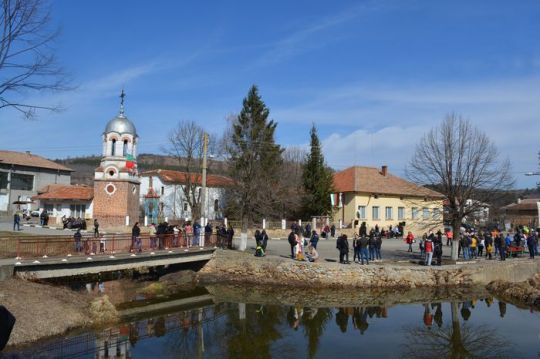
Marble statue of Ephebus
Staircase {down) on the Wall.—Large bas-relief of a Thracian horseman from Salonica, 3rd cent. B.c.
BOOM HO. 20.—Marble statues and friezes of Boman period from Aphrodisias.
BOOM NO. 21.—On entering: A marble statue of Ephebus standing, from Tralles. This is one of the finest marble statues of the Museum, and it belongs to the Hellenistic art, i.e., about the 3rd cent. B.c. On the right: Archaic statues. On the left: Statues of the Hellenistic period. Head of Alexander the Great from Cos. Head of Alexander the Great (part of the nose broken) from Pergamos. Bust of Apollo from Tralles, 3rd cent. B.c. This statue was not cut out of a single block, but consisted originally of six pieces held together by clamps.
BOOM NO. 22.—On the right: Statues of the Greco-Roman period. On the left of the Roman period: Statue of Hadrian from Crete, and representing the Emperor standing and trampling on the figure of a child representing Cyrenaica Yicta. Statue of Nero from Tralles.
ROOM NO. 23,OR BYZANTINE HALL.—(On the floor) large mosaic from Syria discovered by Prof. H. Butler of Princeton University. Also several other marble objects of the early Christian period.
ROOM NO. 24.—Marble statues of Roman period.
ROOM NO. 25.—Assyrian statues.
Archaic statue of Hercules
ROOM NO. 26, OR HERCULES ROOM.—Archaic statue of Hercules from Cyprus represented as killing a Ron. Also Assyrian statues.
ROOM NO. 27.—Various funereal steles, mostly from tombs in Asia Minor.
ROOM NO. 1
The sarcophagus called the Satrap’s, No. 18, was unearthed at Saida in 1887 by Hamdi Bey and his party. It is of Paros marble, and was originally painted; traces of blue are still visible on one of its faces, the rest of the colouring having been effaced, and the carvings themselves much worn, by the action of the water which filled the chamber of the catacomb in which it was discovered. One of the comers of the trough and lid was unfortunately broken off during the excavating operations, but the fragments have now been pieced together again.
This sarcophagus, in its general aspect, represents a Greek temple. The trough is in the form of a truncated pyramid, and is anthropoid inside; the bottom is adorned with a row of rais de cceur, and the top with a row of pearls and ovulae; on the sides are four sculptured panels in a framing of carved palm-leaves.
The head or northern panel, represents a funeral banquet. The corpse is depicted laid out on a bier, and is evidently that of some Oriental potentate or satrap, with a long beard and hair bound with a head-band, and clad in long flowing robes. Its left hand grasps a goblet, while its right holds a rhyton, and is extended towards a female figure in a long tunic and with hair confined by a head- band, who stands in front of him in the act of replenishing the rhyton from an oenochoe. Behind the woman is another seated on a chair, and with part of her himcdion drawn over her head, while yet another female figure is depicted towards the satrap’s right.
0 notes
Text
#MosaicMonday:

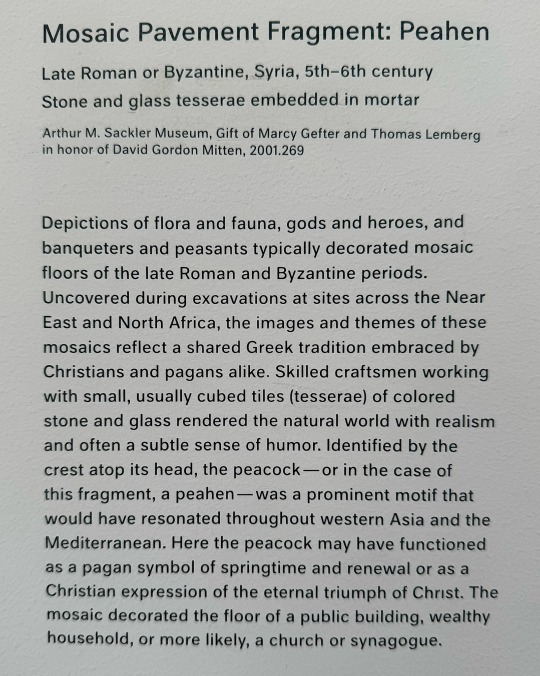
Mosaic Pavement Fragment: Peahen
Late Roman or Byzantine, Syria, 5th-6th c.
Stone & glass tesserae embedded in mortar
on display at Harvard Art Museums
“Identified by the crest atop its head, the peacock— or in the case of this fragment, a peahen — was a prominent motif that would have resonated throughout western Asia and the Mediterranean. Here the peacock may have functioned as a pagan symbol of springtime and renewal or as a Christian expression of the eternal triumph of Christ.“
#animals in art#museum visit#birds in art#bird#birds#peafowl#peacock#peahen#ancient art#Roman art#Byzantine art#mosaic#Mosaic Monday#Harvard Art Museums
16 notes
·
View notes
Photo
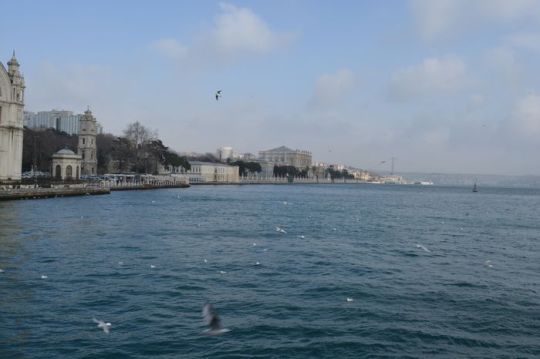
Marble statue of Ephebus
Staircase {down) on the Wall.—Large bas-relief of a Thracian horseman from Salonica, 3rd cent. B.c.
BOOM HO. 20.—Marble statues and friezes of Boman period from Aphrodisias.
BOOM NO. 21.—On entering: A marble statue of Ephebus standing, from Tralles. This is one of the finest marble statues of the Museum, and it belongs to the Hellenistic art, i.e., about the 3rd cent. B.c. On the right: Archaic statues. On the left: Statues of the Hellenistic period. Head of Alexander the Great from Cos. Head of Alexander the Great (part of the nose broken) from Pergamos. Bust of Apollo from Tralles, 3rd cent. B.c. This statue was not cut out of a single block, but consisted originally of six pieces held together by clamps.
BOOM NO. 22.—On the right: Statues of the Greco-Roman period. On the left of the Roman period: Statue of Hadrian from Crete, and representing the Emperor standing and trampling on the figure of a child representing Cyrenaica Yicta. Statue of Nero from Tralles.
ROOM NO. 23,OR BYZANTINE HALL.—(On the floor) large mosaic from Syria discovered by Prof. H. Butler of Princeton University. Also several other marble objects of the early Christian period.
ROOM NO. 24.—Marble statues of Roman period.
ROOM NO. 25.—Assyrian statues.
Archaic statue of Hercules
ROOM NO. 26, OR HERCULES ROOM.—Archaic statue of Hercules from Cyprus represented as killing a Ron. Also Assyrian statues.
ROOM NO. 27.—Various funereal steles, mostly from tombs in Asia Minor.
ROOM NO. 1
The sarcophagus called the Satrap’s, No. 18, was unearthed at Saida in 1887 by Hamdi Bey and his party. It is of Paros marble, and was originally painted; traces of blue are still visible on one of its faces, the rest of the colouring having been effaced, and the carvings themselves much worn, by the action of the water which filled the chamber of the catacomb in which it was discovered. One of the comers of the trough and lid was unfortunately broken off during the excavating operations, but the fragments have now been pieced together again.
This sarcophagus, in its general aspect, represents a Greek temple. The trough is in the form of a truncated pyramid, and is anthropoid inside; the bottom is adorned with a row of rais de cceur, and the top with a row of pearls and ovulae; on the sides are four sculptured panels in a framing of carved palm-leaves.
The head or northern panel, represents a funeral banquet. The corpse is depicted laid out on a bier, and is evidently that of some Oriental potentate or satrap, with a long beard and hair bound with a head-band, and clad in long flowing robes. Its left hand grasps a goblet, while its right holds a rhyton, and is extended towards a female figure in a long tunic and with hair confined by a head- band, who stands in front of him in the act of replenishing the rhyton from an oenochoe. Behind the woman is another seated on a chair, and with part of her himcdion drawn over her head, while yet another female figure is depicted towards the satrap’s right.
0 notes
Photo

Marble statue of Ephebus
Staircase {down) on the Wall.—Large bas-relief of a Thracian horseman from Salonica, 3rd cent. B.c.
BOOM HO. 20.—Marble statues and friezes of Boman period from Aphrodisias.
BOOM NO. 21.—On entering: A marble statue of Ephebus standing, from Tralles. This is one of the finest marble statues of the Museum, and it belongs to the Hellenistic art, i.e., about the 3rd cent. B.c. On the right: Archaic statues. On the left: Statues of the Hellenistic period. Head of Alexander the Great from Cos. Head of Alexander the Great (part of the nose broken) from Pergamos. Bust of Apollo from Tralles, 3rd cent. B.c. This statue was not cut out of a single block, but consisted originally of six pieces held together by clamps.
BOOM NO. 22.—On the right: Statues of the Greco-Roman period. On the left of the Roman period: Statue of Hadrian from Crete, and representing the Emperor standing and trampling on the figure of a child representing Cyrenaica Yicta. Statue of Nero from Tralles.
ROOM NO. 23,OR BYZANTINE HALL.—(On the floor) large mosaic from Syria discovered by Prof. H. Butler of Princeton University. Also several other marble objects of the early Christian period.
ROOM NO. 24.—Marble statues of Roman period.
ROOM NO. 25.—Assyrian statues.
Archaic statue of Hercules
ROOM NO. 26, OR HERCULES ROOM.—Archaic statue of Hercules from Cyprus represented as killing a Ron. Also Assyrian statues.
ROOM NO. 27.—Various funereal steles, mostly from tombs in Asia Minor.
ROOM NO. 1
The sarcophagus called the Satrap’s, No. 18, was unearthed at Saida in 1887 by Hamdi Bey and his party. It is of Paros marble, and was originally painted; traces of blue are still visible on one of its faces, the rest of the colouring having been effaced, and the carvings themselves much worn, by the action of the water which filled the chamber of the catacomb in which it was discovered. One of the comers of the trough and lid was unfortunately broken off during the excavating operations, but the fragments have now been pieced together again.
This sarcophagus, in its general aspect, represents a Greek temple. The trough is in the form of a truncated pyramid, and is anthropoid inside; the bottom is adorned with a row of rais de cceur, and the top with a row of pearls and ovulae; on the sides are four sculptured panels in a framing of carved palm-leaves.
The head or northern panel, represents a funeral banquet. The corpse is depicted laid out on a bier, and is evidently that of some Oriental potentate or satrap, with a long beard and hair bound with a head-band, and clad in long flowing robes. Its left hand grasps a goblet, while its right holds a rhyton, and is extended towards a female figure in a long tunic and with hair confined by a head- band, who stands in front of him in the act of replenishing the rhyton from an oenochoe. Behind the woman is another seated on a chair, and with part of her himcdion drawn over her head, while yet another female figure is depicted towards the satrap’s right.
0 notes
